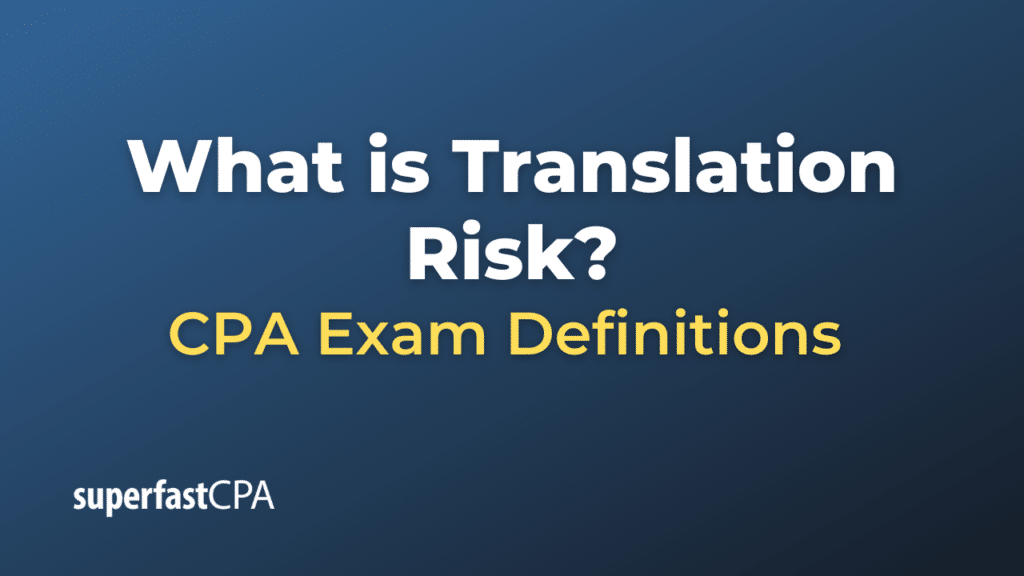Translation Risk
Translation risk, often referred to as translation exposure or accounting exposure, pertains to the potential changes in a company’s reported financial statements due to fluctuations in exchange rates. This risk emerges when companies consolidate the financial statements of their foreign subsidiaries, translating them from the subsidiary’s functional currency to the parent company’s reporting currency.
Key aspects to understand about translation risk include:
- Nature of Risk: This risk does not imply a real cash flow effect for the firm. Instead, it affects the company’s consolidated reported figures.
- Origin of the Risk: Companies operating in multiple countries often maintain financial records in the local currency of each country. When these figures are consolidated into the parent company’s financial statements, they are translated into the parent’s reporting currency. Variations in exchange rates between periods can lead to fluctuations in these translated amounts.
- Effect on Financial Statements: Translation risk primarily impacts the balance sheet, income statement, and the equity section. Under some translation methods, adjustments due to exchange rate variations are reported in a separate equity account, often referred to as the “cumulative translation adjustment” (CTA) within accumulated other comprehensive income.
- Managing the Risk : Given that translation risk doesn’t involve actual cash flows, many companies simply accept this accounting risk. However, for economic risks that do involve cash flow implications, companies often employ hedging strategies using financial derivatives like forward contracts, options, or swaps.
- Stakeholder Consideration : While translation risk doesn’t alter a company’s operational performance or cash flows, it can influence reported assets, liabilities, and equity. Investors and analysts should recognize this when evaluating a company’s financial health.
In essence, translation risk underscores the potential variability in a company’s reported financials due to exchange rate fluctuations when consolidating the accounts of foreign operations.
Example of Translation Risk
Let’s use a fictional scenario to illustrate translation risk.
Background:
- MegaCorp is a U.S.-based company with a subsidiary in the UK named BritSub.
- MegaCorp consolidates its financial statements in U.S. Dollars (USD), while BritSub maintains its records in British Pounds (GBP).
- At the beginning of 2023, the exchange rate is $1.30/GBP.
- By the end of 2023, the exchange rate moves to $1.40/GBP.
- BritSub’s balance sheet for 2023 shows assets of £500,000 and liabilities of £300,000.
Translation at the Start of 2023:
Let’s imagine BritSub’s assets and liabilities were the same at the beginning of 2023:
Translated assets = £500,000 × $1.30/GBP = $650,000
Translated liabilities = £300,000 × $1.30/GBP = $390,000
Net assets (equity) = $650,000 – $390,000 = $260,000
Translation at the End of 2023:
Using the end-of-year exchange rate:
Translated assets = £500,000 × $1.40/GBP = $700,000
Translated liabilities = £300,000 × $1.40/GBP = $420,000
Net assets (equity) = $700,000 – $420,000 = $280,000
Translation Risk Realization:
Net assets at the start of the year = $260,000
Net assets at the end of the year = $280,000
Change due to currency translation = $280,000 – $260,000 = $20,000
This $20,000 increase is the translation adjustment and would be recorded in MegaCorp’s consolidated balance sheet under accumulated other comprehensive income as a “cumulative translation adjustment” (CTA).
In this example, the GBP strengthened against the USD, leading to an increase in the reported USD value of BritSub’s net assets when consolidated into MegaCorp’s financials. This change doesn’t represent a real gain for MegaCorp; it’s merely an accounting effect. However, it highlights the translation risk MegaCorp faces due to its foreign operations and the ensuing currency fluctuations.












